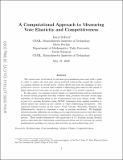A Computational Approach to Measuring Vote Elasticity and Competitiveness
Author(s)
DeFord, Daryl; Duchin, Moon; Solomon, Justin
DownloadSubmitted version (4.223Mb)
Open Access Policy
Open Access Policy
Creative Commons Attribution-Noncommercial-Share Alike
Terms of use
Metadata
Show full item recordAbstract
© 2020 The Author(s). Published with license by Taylor and Francis Group, LLC. The recent wave of attention to partisan gerrymandering has come with a push to refine or replace the laws that govern political redistricting around the country. A common element in several states’ reform efforts has been the inclusion of competitiveness metrics, or scores that evaluate a districting plan based on the extent to which district-level outcomes are in play or are likely to be closely contested. In this article, we examine several classes of competitiveness metrics motivated by recent reform proposals and then evaluate their potential outcomes across large ensembles of districting plans at the Congressional and state Senate levels. This is part of a growing literature using MCMC techniques from applied statistics to situate plans and criteria in the context of valid redistricting alternatives. Our empirical analysis focuses on five states—Utah, Georgia, Wisconsin, Virginia, and Massachusetts—chosen to represent a range of partisan attributes. We highlight situation-specific difficulties in creating good competitiveness metrics and show that optimizing competitiveness can produce unintended consequences on other partisan metrics. These results demonstrate the importance of (1) avoiding writing detailed metric constraints into long-lasting constitutional reform and (2) carrying out careful mathematical modeling on real geo-electoral data in each redistricting cycle.
Date issued
2020Department
Massachusetts Institute of Technology. Computer Science and Artificial Intelligence LaboratoryJournal
Statistics and Public Policy
Publisher
Informa UK Limited